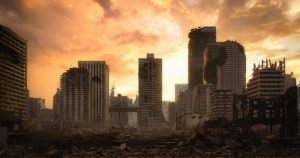When Ukraine recaptured Kherson in November, Andrii Povod returned to find his grain farm in ruins. Two tractors were missing, most of the wheat was gone and all 11 buildings used to store crops and machinery had been bombed and burned. The farm bears the scars of Russian shelling and unexploded ordnance riddles the fields but it’s the less visible damage to Ukraine’s famously fertile soil after a year of war that could be the hardest to repair. Scientists looking at soil samples taken from the recaptured Kharkiv region in northeastern Ukraine found that high concentrations of toxins such as mercury and arsenic from munitions and fuel are polluting the ground. Using the samples and satellite imagery, scientists at Ukraine’s Institute for Soil Science and Agrochemistry Research estimated that the war has degraded at least 10.5 million hectares of agricultural land across Ukraine so far, according to the research shared with Reuters. That’s a quarter of the agricultural land, including territory still occupied by Russian forces, in a country described as the breadbasket of Europe. For our region, it’s a very big problem. This good soil, we cannot reproduce it,” said Povod, 27, walking around his farm near Bilozerka in southeast Ukraine, about 10 km (6 miles) from the Dnipro River that is one of the war’s front lines. Two dozen experts who spoke with Reuters, including soil scientists, farmers, grain companies and analysts, said it would take decades to fix the damage to Europe’s breadbasket – including contamination, mines and destroyed infrastructure – and that global food supplies could suffer for years to come. Shelling has also upset the delicate ecosystems of microorganisms that turn soil materials into crop nutrients such as nitrogen while tanks have compressed the earth, making it harder for roots to flourish, the scientists say. Some areas are so mined and physically transformed by craters and trenches that, like some World War One battlefields, they may never return to farm production, some experts say.

LOSS OF FERTILITY
Before the war, Ukraine was the world’s fourth-largest corn exporter and fifth-biggest wheat seller, and a key supplier to poor countries in Africa and the Middle East that depend on grain imports. After Russia’s invasion a year ago, global grain prices climbed as the Black Sea ports that usually ship Ukraine’s harvest closed, exacerbating inflation rates around the world. The war damage could cut Ukraine’s potential grain harvest by 10 to 20 million tonnes a year, or up to a third based on its pre-war output of 60 to 89 million tonnes, the Soil Institute’s director, Sviatoslav Baliuk told Reuters. Other factors are also important for production levels, such as the area of land farmers plant, climate change, the use of fertilisers and adoption of new farming technology. Ukraine’s agriculture ministry declined to comment about soil contamination and long-term harm to the industry. Besides the damage to the soil, Ukrainian farmers are struggling with unexploded shells in many fields, as well as the destruction of irrigation canals, crop silos and port terminals. Andriy Vadaturskyi, chief executive of Nibulon, one of Ukraine’s biggest grain producers, expects demining alone to take 30 years and said urgent financial help was needed to keep Ukrainian farmers in business. “Today, there is a problem of high prices but the food is available,” Vadaturskyi said in an interview. “But tomorrow, in one year’s time, it could be the situation if there is no solution, that it will be a shortage of food.” Ukraine’s most fertile soil – called chernozem – has suffered the most, the institute found. Chernozem is richer than other soils in nutrients such as humus, phosphorus and nitrogen and extends deep into the ground, as much as 1.5 metres. The institute’s Baliuk said the war damage could lead to an alarming loss of fertility. Increased toxicity and reduced diversity of microorganisms, for example, have already reduced the energy corn seeds can generate to sprout by an estimated 26%, resulting in lower yields, he said, citing the Institute’s research.

ECHOES OF WORLD WAR ONE
A working group of soil scientists created by the Ukrainian government estimates it would cost $15 billion to remove all mines and restore Ukraine’s soil to its former health. That restoration can take as little as three years, or more than 200, depending on the type of degradation, Baliuk said. If studies of damage to land during World War One are anything to go by, some areas will never recover. U.S. academics Joseph Hupy and Randall Schaetzl, coined the term “bombturbation” in 2006 to describe war’s impact on soil. Among the unseen damage, bomb breaches in bedrock or soil layers can change the water table’s depth, depriving vegetation of a shallow water source, they wrote. At a former World War One battlefield near Verdun, France, some pre-war grain fields and pastures have gone unfarmed for more than a century due to craters and unexploded shells, a 2008 paper by Remi de Matos-Machado and Hupy said. Hupy told Reuters that some arable land in Ukraine, too, may never return to crop production due to its contamination and topographic alteration. Many other fields will require significant earth-moving to relevel the ground, along with demining on a massive scale, Hupy said. Naomi Rintoul-Hynes, senior lecturer in soil science and environmental management at Canterbury Christ Church University, studied soil contamination from World War One and fears the conflict in Ukraine is doing similar, irreversible damage. “It is of utmost importance that we understand how bad the situation is as it stands,” she said. Lead, for example, has a half-life of 700 years or more, meaning it may take that long for its concentration in the soil to decrease by half. Such toxins can accumulate so much in plants growing there that human health may become affected, Rintoul-Hynes said. To be sure, World War One lasted four years, and the war in Ukraine only one year so far, but lead remains a key component of many modern munitions, Rintoul-Hynes said.
DEMINING CHALLENGE
Removing mines and other unexploded ordnance, which cover 26% of Ukraine’s land according to the government, will likely take decades, said Michael Tirre, Europe program manager for the U.S. State Department’s Office of Weapons Removal. Andrii Pastushenko’s dairy farm in southeastern Ukraine, where he grows cattle feed and sunflowers, is pockmarked with craters and former Russian bunkers. Though Ukraine recaptured the area in November, Russian forces shell his farm regularly from across the Dnipro River, blowing new holes in his fields and scattering unexploded ordnance, he said. “We need many months to clear everything and continue to work, maybe years,” said Pastushenko, 39. “There is no help because we are on the first line of fire. No one will help while this is a war zone.” There is currently no work underway on demining farms in the Kherson region because of a limited number of specialists, said Oleksandr Tolokonnikov, a spokesperson for the Kherson Regional Military Administration. With so little help available, grain company Nibulon has created a small division dedicated to demining its land in southern Ukraine, a process expected to last decades, Mykhailo Rizak, Nibulon’s deputy director told Reuters.
“This is a very serious problem for Nibulon,” Rizak said.
There’s another long-term problem for Ukraine’s agricultural sector, which accounted for 10% of its gross domestic product before the war. That’s the damage to roads, railways and other infrastructure estimated at $35.3 billion and counting, the Kyiv School of Economics said in October. “People think as soon as peace is achieved, the food crisis will be solved,” said Caitlin Welsh, director of global food security at the Center for Strategic & International Studies in Washington. “With Ukraine, just repairing the infrastructure is going to take a really long time.” Farmers’ finances are also in a desperate state, said Dmitry Skornyakov, chief executive of HarvEast, a major Ukrainian farming company. Many farmers can survive this year, living off the income of a bumper year just before the war, said Skornyakov, but he predicts up to half will have severe financial problems if the conflict drags into 2024.















